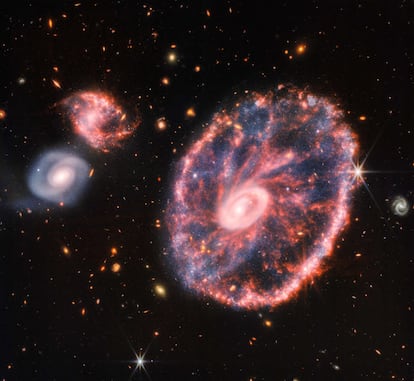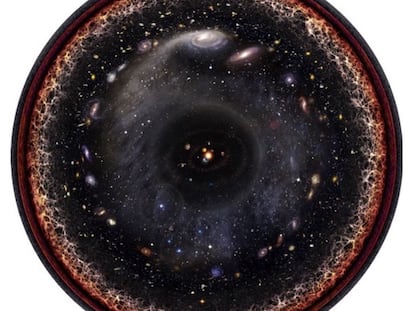James Webb telescope reveals spectacular image of Cartwheel Galaxy
The space observatory provides a new view of the star formation, which is located 500 million light-years away from Earth

As new scientific results begin to emerge from its observations, the powerful James Webb telescope continues to show its potential with detailed and spectacular views of ancient celestial bodies, such as the recently released image of the Cartwheel Galaxy.
Because of the new telescope’s high-precision instruments, this galaxy’s individual stars and star-forming regions can now be observed at high resolution. The Webb telescope has also revealed the behavior of the black hole at the center of the Cartwheel Galaxy, a formation located about 500 million light-years away in the Sculptor constellation.
According to Webb scientists, the Cartwheel is a rare lenticular galaxy that was once shrouded in dust and mystery. The galaxy formed as a result of a collision between a large spiral galaxy and a smaller galaxy, which caused massive changes throughout the Cartwheel Galaxy’s structure. The collision caused the resulting galaxy to sport two rings: a bright inner one and a surrounding colorful one. “These two rings expand outwards from the center of the collision, like ripples in a pond after a stone is tossed into it. Because of these distinctive features, astronomers call this a ‘ring galaxy,’ a structure less common than spiral galaxies like our Milky Way,” the European Space Agency (ESA) explained in a press release.
The James Webb telescope is an expensive and sophisticated scientific observatory that was launched into space on December 25. A few weeks later, it reached its orbit 1.5 million kilometers away from Earth. US President Joe Biden presented the Webb telescope’s first images. They show the potential of the space observatory, which was developed in collaboration with Europe and Canada. Webb can see further into the universe than any other telescope, and it can even capture light from the first stars born after the Big Bang, 13.7 billion years ago.
Tu suscripción se está usando en otro dispositivo
¿Quieres añadir otro usuario a tu suscripción?
Si continúas leyendo en este dispositivo, no se podrá leer en el otro.
FlechaTu suscripción se está usando en otro dispositivo y solo puedes acceder a EL PAÍS desde un dispositivo a la vez.
Si quieres compartir tu cuenta, cambia tu suscripción a la modalidad Premium, así podrás añadir otro usuario. Cada uno accederá con su propia cuenta de email, lo que os permitirá personalizar vuestra experiencia en EL PAÍS.
¿Tienes una suscripción de empresa? Accede aquí para contratar más cuentas.
En el caso de no saber quién está usando tu cuenta, te recomendamos cambiar tu contraseña aquí.
Si decides continuar compartiendo tu cuenta, este mensaje se mostrará en tu dispositivo y en el de la otra persona que está usando tu cuenta de forma indefinida, afectando a tu experiencia de lectura. Puedes consultar aquí los términos y condiciones de la suscripción digital.
More information
Últimas noticias
Most viewed
- Reinhard Genzel, Nobel laureate in physics: ‘One-minute videos will never give you the truth’
- Oona Chaplin: ‘I told James Cameron that I was living in a treehouse and starting a permaculture project with a friend’
- Pablo Escobar’s hippos: A serious environmental problem, 40 years on
- Charles Dubouloz, mountaineering star, retires at 36 with a farewell tour inspired by Walter Bonatti
- Why we lost the habit of sleeping in two segments and how that changed our sense of time









































